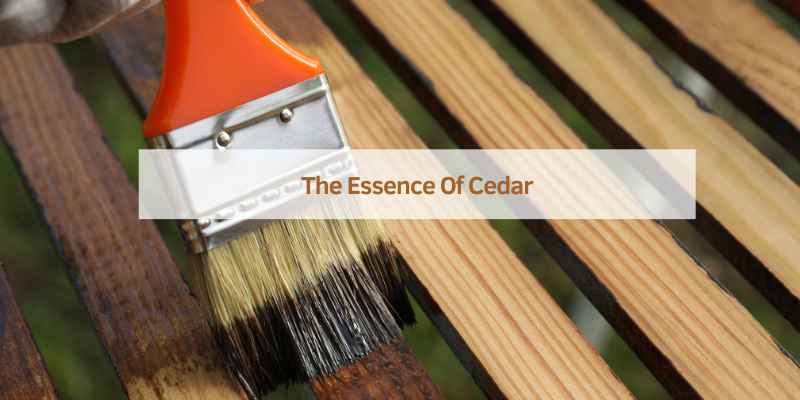Cedar does not need to be treated. It naturally resists rot, decay, and insect damage.
Cedar wood is a popular choice for outdoor structures. Its natural oils make it resistant to weather and pests. This durability means cedar often lasts longer without treatment. While treating cedar can enhance its longevity and appearance, it isn’t always necessary.
Untreated cedar develops a charming, silver-gray patina over time. Some homeowners prefer this natural aging process. Others opt for stains or sealants to maintain cedar’s original color. Proper maintenance can further extend cedar’s lifespan. Regular cleaning and occasional refinishing help keep cedar looking its best. Whether you treat it or not, cedar remains a robust and attractive option for many outdoor projects.
The Essence Of Cedar
Cedar wood naturally resists rot and insects due to its oils. Treating cedar can extend its lifespan and enhance appearance. This maintenance ensures the wood remains resilient in various weather conditions.
Natural Resilience
Cedar is a very strong wood. It resists rot and decay. Insects do not like cedar. This makes it a good choice for outdoor use. Cedar does not warp or crack easily. This helps it last longer.
Aromatic Qualities
Cedar has a pleasant smell. This smell is natural and lasts a long time. The aroma helps keep bugs away. Many people like to use cedar in closets. The smell keeps clothes fresh. Cedar is also used in homes for its nice scent.

Cedar’s Enemy: The Elements
Cedar naturally resists decay and insects, but treating it can enhance longevity. Unprotected cedar may weather and lose its rich color. Proper treatment ensures cedar withstands harsh elements.
Moisture And Rot Resistance
Cedar is naturally resistant to moisture and rot. This makes it great for outdoor use. Even so, it does need some care to last longer. Over time, water can still damage cedar. Applying a sealant can help protect it. This stops water from seeping into the wood. Make sure to reapply the sealant regularly. Doing this will keep your cedar looking good.
Sunlight And Fading
Sunlight can cause cedar to fade. The wood can turn gray over time. This is due to UV rays from the sun. Using a UV-blocking stain can help. This protects the wood from harmful rays. Reapply the stain every few years. This will help maintain the wood’s color. Proper care will keep your cedar beautiful for many years.
Life Expectancy Of Untreated Cedar
Untreated cedar typically lasts 15 to 30 years. Its natural oils provide some resistance to decay and insects. Treating cedar can enhance its durability and lifespan significantly.
Durability In Different Climates
Untreated cedar wood can last for many years. In dry climates, cedar can last up to 40 years. In humid climates, its lifespan may be shorter. Cedar is resistant to rot and insects. This makes it a popular choice for outdoor use. The wood’s natural oils help to protect it. Regular maintenance can extend its life. Cedar is often used for fences and decks. It can withstand harsh weather conditions.
As cedar ages, it changes in appearance. The wood may turn a silvery-gray color. This is natural and does not affect its strength. Some people like this aged look. Others prefer to stain the wood to keep its original color. Staining or sealing can protect cedar from moisture. Over time, the wood may develop small cracks. These are usually not a problem. Regular inspections can help spot any issues early. Cedar remains strong and durable, even as it ages.
Benefits Of Treating Cedar
Treating cedar enhances its durability and resistance to pests and weather damage. It also maintains the wood’s natural beauty and extends its lifespan.
Enhanced Longevity
Treating cedar wood makes it last longer. It helps to prevent damage from pests and weather. Cedar wood can resist decay better with treatment. Treated cedar can stay strong for many years. This means less repair and replacement costs. It is a good investment for long-term use.
Color Preservation
Cedar wood has a beautiful color. Treatment helps to keep this color bright. Without treatment, the color can fade over time. Treated cedar wood looks new for longer. This keeps your furniture or structures looking great. It also adds more value to your property.
Common Treatment Options
Sealants help to protect cedar from moisture and UV rays. They create a protective barrier on the wood’s surface. Stains can add color and also offer protection. They penetrate deep into the wood. Stains come in various shades. They help to enhance the natural beauty of cedar.
Oil treatments keep cedar looking fresh. They nourish the wood and help to prevent cracking. Linseed oil is a popular choice. Tung oil is another good option. Both oils penetrate deeply and protect the wood. They maintain the wood’s natural look and feel.
Application Techniques
Cedar naturally resists decay and insects, often eliminating the need for treatment. For enhanced longevity, apply a sealer or stain. Regular maintenance ensures cedar’s durability and aesthetic appeal.
Professional Vs DIY
Professional treatment ensures proper application. Experts have the right tools and knowledge. They use high-quality products. This gives your cedar long-lasting protection. DIY treatment can save money. You can buy products from a store. But, you must follow the instructions carefully. Mistakes can damage the wood. Consider your skills before starting a DIY project.
Frequency Of Treatment
Cedar needs regular care. Treat your cedar every 2-3 years. This keeps it in good condition. Weather and climate affect the treatment frequency. Wet areas may need more frequent care. Dry areas might need less frequent care. Always check your cedar for signs of wear. Treat it sooner if needed.
Environmental Considerations
Cedar wood is naturally resistant to pests and decay. Using eco-friendly treatments helps keep the environment safe. These treatments do not harm plants or animals. They also help the wood last longer without chemicals.
Treating cedar can affect local ecosystems. Chemicals can leak into soil and water. This can harm fish and wildlife. Using natural treatments helps protect these ecosystems. Cedar is a good choice for green building projects.
Making The Right Choice
Cedar is a durable wood that resists rot and insects. Untreated cedar can last for many years. Treating cedar can extend its lifespan even more. Treatment costs money and time. Untreated cedar has a natural beauty. Treated cedar may lose some of its natural look. Weighing the costs and benefits can help you decide.
Personal preferences matter when choosing cedar. Some people love the natural look of untreated cedar. Others prefer the even color of treated wood. Consider the look you want for your space. Natural cedar has a rich, warm color. Treated cedar can be stained any color. Your choice depends on your taste.

Frequently Asked Questions
Can Cedar Be Left Untreated?
Yes, cedar can be left untreated. It naturally resists rot, decay, and insects, making it durable outdoors. Over time, it will weather to a silver-gray patina. Regular maintenance is optional.
Do I Need To Seal Cedar Wood?
Sealing cedar wood is optional but recommended. It helps protect the wood from moisture, UV rays, and pests. Unsealed cedar can weather naturally, turning a silver-gray color. Sealing maintains its original appearance and extends its lifespan.
Does Cedar Wood Need To Be Treated For Outdoor Use?
Cedar wood is naturally resistant to decay and insects. Treating cedar can enhance its durability and appearance for outdoor use.
Can I Leave My Cedar Deck Untreated?
Yes, you can leave your cedar deck untreated. It will weather to a silver-gray color. Regular cleaning is essential to prevent mold and mildew.
Conclusion
Treating cedar wood can extend its lifespan and enhance its appearance. Natural oils provide resistance against pests and decay. Regular maintenance ensures cedar remains durable and beautiful. Choose the right treatment based on your specific needs. Proper care will keep your cedar projects looking great for years.

